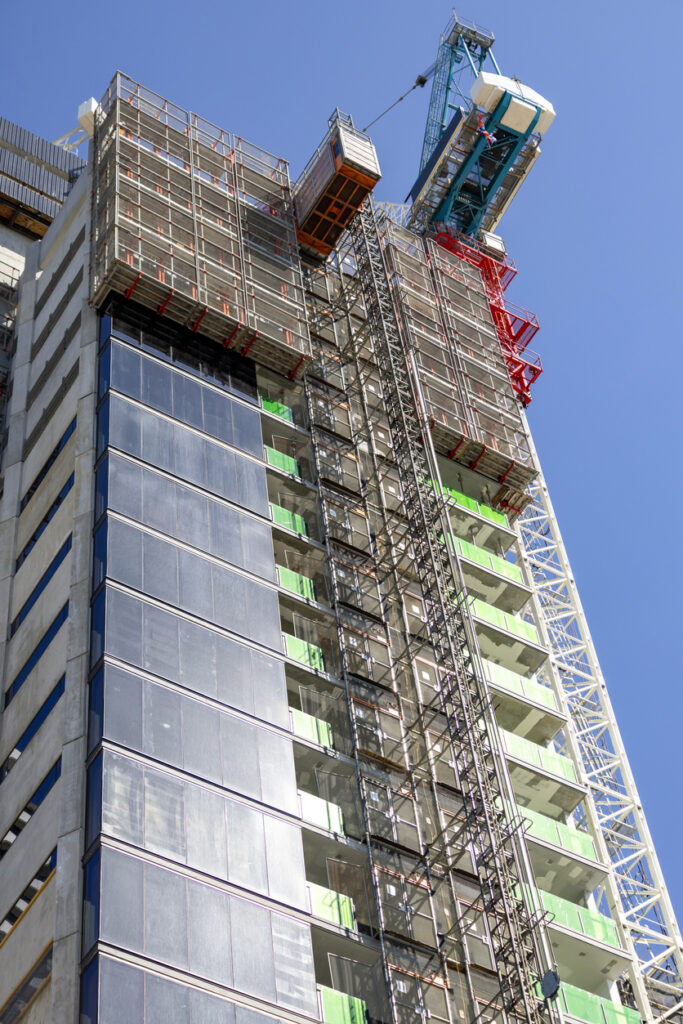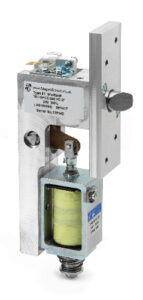How our special electric locks help to keep construction sites safe.
 We are in the fortunate position to supply several of the lift industry’s premium manufacturers, notably those that provide goods hoists used on construction sites to transport tools, equipment, materials and sometimes people to the floors of a building under construction.
We are in the fortunate position to supply several of the lift industry’s premium manufacturers, notably those that provide goods hoists used on construction sites to transport tools, equipment, materials and sometimes people to the floors of a building under construction.
Our big-name customers include a Dutch manufacturer via our colleagues at Rotero in The Netherlands, a Swedish goods hoists and lifts manufacturer, and a company based in Spain. While the products from these manufacturers vary, they all use a rack & pinion design to drive a ‘car’ up the side of a building. The specs and regulations in this sector are not quite as stringent as the Lifts Directive for passenger lifts; they are more aligned with the Disability Discrimination Act 1995 specs for platform lifts.
At Magnet Schultz, we do well in the goods hoist market because – apart from the fact that nobody does what we do – our solenoid-based electric locking products meet the requirements of the sector’s specification, which is related to the lower speeds of these hoists compared to passenger lifts.
Gates on each floor
With the UK goods hoist application, every floor on the side of the building under construction has a sliding gate, which must be locked when the car is on another floor. It unlocks automatically when the car reaches the landing. We provide that electric lock. They are somewhat unusual in being “temporary” locks; with the construction of a tall building typically addressing a few floors at a time, a series of Magnet Schultz locks will be deployed on, say, floors 1 to 10. These are then moved up to floors 11 to 20, once construction and goods deliveries for those lower floors are complete. Those Magnet Schultz locks are affixed to the building.
Locking the car doors
For a similar but subtly different application of our solenoid locks, look at the passenger /goods hoists. Here, our locks are installed in the travelling car that ascends the side of the building under construction. We lock the sliding doors of the car, most of which comprise a single or pair of doors or shutters (often fabricated from steel mesh) that typically operate in the vertical plane. These hoist cars must lock mechanically and electrically to adhere to the safety interlock regulations. We see to that.
One of the areas in which we excel in this sector is our ability to design locks that meet some strict regulatory requirements. For instance, our solenoid locks are designed to be IP65 compliant, featuring bellows seal, gaskets and, importantly, ‘positive break’ safety switches (aka forced contact switches) to eliminate any chance of a false safe reading. It’s the same type of switch we use (for the same reason) in our DDA-compliant (Disability Discrimination Act) platform lifts.


Inside, not outside
A more recent innovation in the construction of tall buildings is to build around the lift shaft, which will become the passenger lift when construction is completed. Now the hoist is put in that shaft, which is not on the outside of the building. And that requires a special lift lock. Here, the safety gates are on the landing and not the car. On the outside of buildings, skids are often fitted to the car to automatically open the gates mechanically as the car reaches the floor – known as a ‘retiring ramp’ mechanism. Skids are not used on a lift shaft inside a building. Instead, a custom electric lock design is needed to unlock the gates on each landing when the car has arrived. We design and manufacture those locks for several prominent hoist manufacturers.
In some goods hoist applications, our EBL-I industrial lock – or a customised variant of it – is used as an alternative to a popular method of automated mechanical unlocking called a ‘slam post’. This usually comprises an interlock system that features twin forks that engage as the car ‘slams’ (the clue is in the name. However, some fork mechanisms are not robust enough to withstand the brutal environment of a construction site. In contrast, the EBL-I is more rugged and reliable.
Exhaustive testing for operational confidence


These days, we test for two million operations. Similarly, we take samples of locking subassemblies that use the GFCX 040 solenoid and test them to a million operations or more as well. After conducting that life test, we write a report that’s matched to the customer’s documentation needs, making it straightforward for them to demonstrate compliance with regulations – for example the Disability Discrimination Act 1995 (DDA), where our platform lift locks based on the GFCX 040 solenoid fully satisfy the requirements of the EN81-41-43 Machinery Directive.
TALL for passengers


In common with our famed ability to tailor our solenoid actuator technology to produce bespoke solutions, TALL is built into a smaller envelope to fit existing lift infrastructure. The design goal for this more compact packaging is that lift manufacturers can deploy the lock without needing to modify any lift framework.
And again, in keeping with our commitment to flexibility, we can customise the TALL design to provide different features, like alternate bolt lengths and other options to suit the needs of any customer.
You can see the new TALL at the forthcoming LIFTEX event in London’s docklands on 11th and 12th June. We will be exhibiting on Stand C0 where you can get hands-on with TALL and many of our other actuator products designed for the hoist and lift sector.
Please register here for LIFTEX for free, with our compliments.
